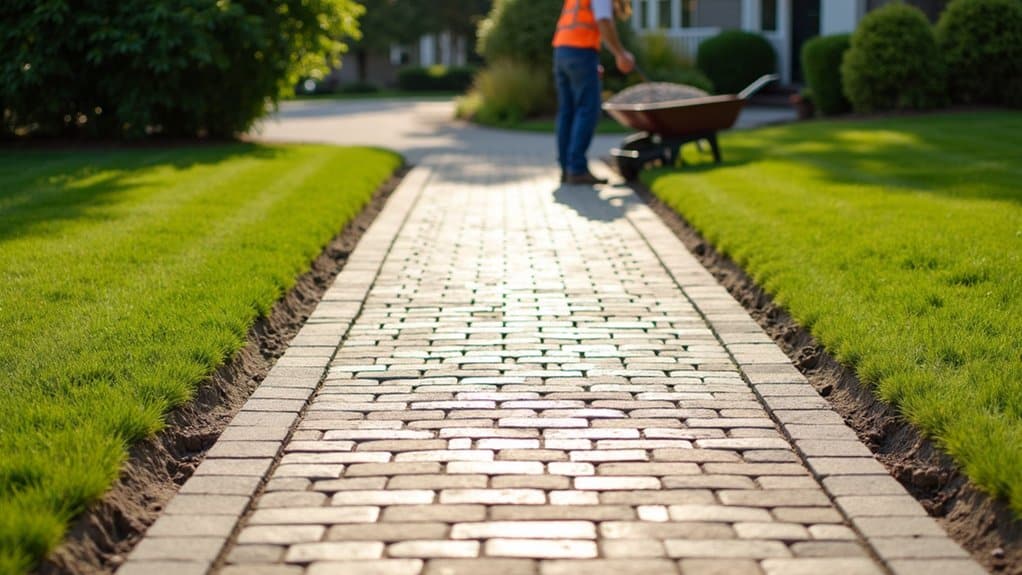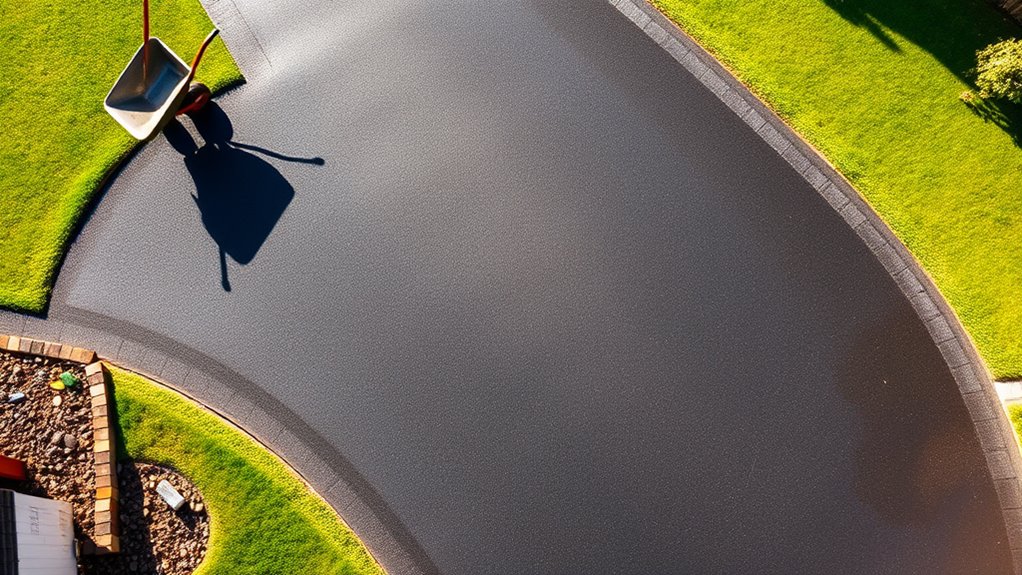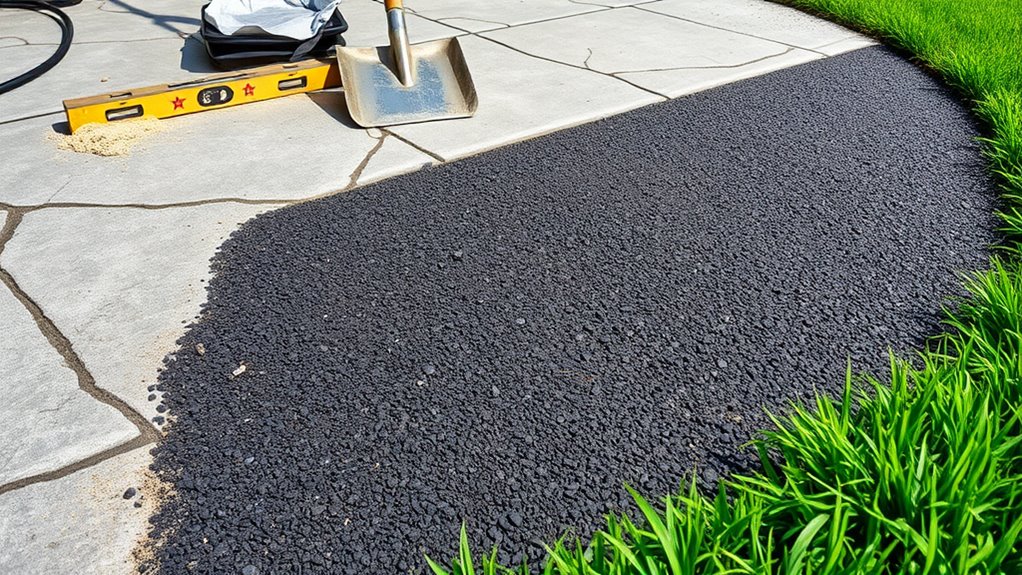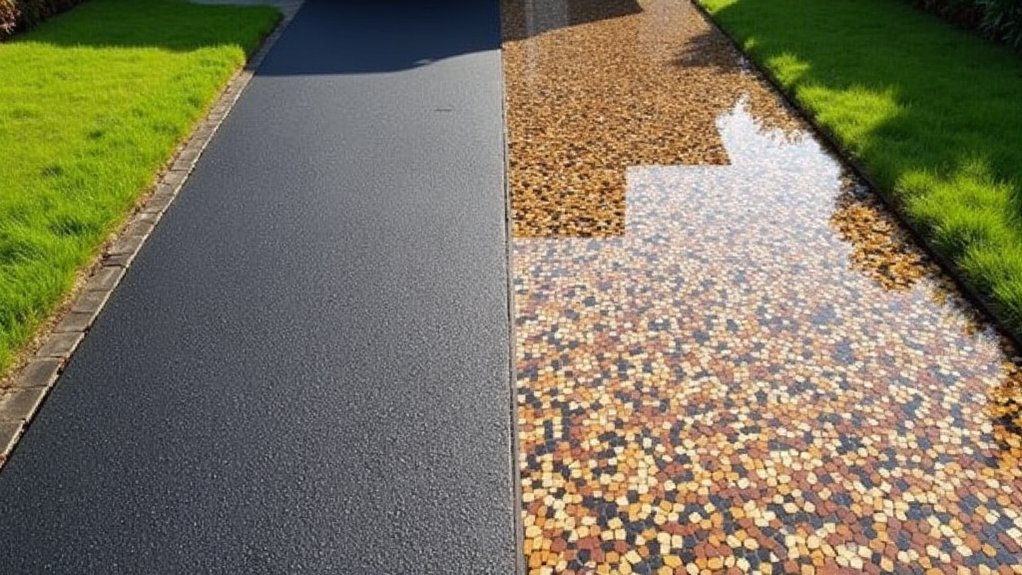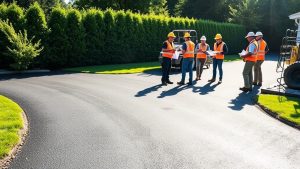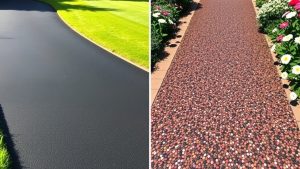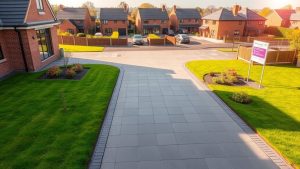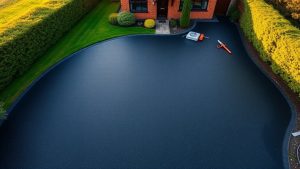To lay a driveway on a sloped surface, begin by choosing a suitable base material, such as crushed stone or permeable pavers, to ensure stability and proper drainage. Prepare the base layer by compacting it and maintaining a slight slope for effective water runoff. When laying interlocking pavers, start from the bottom and work upwards for better alignment. It’s also essential to incorporate drainage solutions, like channel drains, to manage water flow. For additional guidance on erosion control and sustainable materials, consider exploring further techniques.
Table of Contents
ToggleKey Takeaways
- Ensure a gentle slope in the sub-base to facilitate proper water runoff before laying the driveway material.
- Opt for a stable base material, such as Type 1 or crushed stone, to ensure effective drainage and adequate support.
- Compact the base layer thoroughly to prevent settling and maintain the driveway’s integrity on the slope.
- Install suitable drainage solutions, like trench drains or swales, to manage surface water and prevent erosion.
- Regularly check and maintain the driveway, especially after heavy rain, to address any issues with erosion or settling.
Base Material Selection for Sloped Driveways
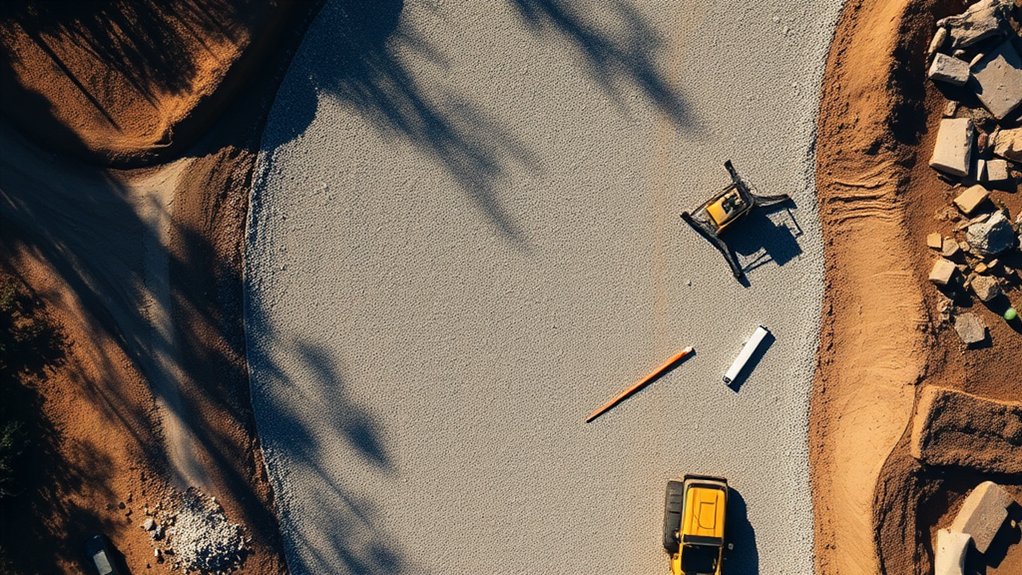
Choosing the right base material for a sloped driveway is crucial for ensuring stability and longevity. Your selection will significantly affect durability and installation costs. Crushed stone provides excellent drainage and stability, but it can shift without proper compaction. Gravel, such as CA6 Road Mix, is a budget-friendly option that also offers good drainage and stability, though it requires regular maintenance. Permeable pavers allow water to drain away, reducing erosion risks, but they come with a higher installation price tag. Concrete offers maximum stability but requires professional installation and may crack in extreme weather. Asphalt creates a smooth surface suitable for heavy traffic but needs regular sealing to maintain its condition. Additionally, selecting the right material contributes to a solid foundation that can withstand heavy vehicle traffic and weather conditions. A solid sub base is vital for durable resin driveway installation when selecting the best material, consider factors like the slope gradient, drainage requirements, and the weight of the vehicles that will use the driveway. This will help ensure you choose a durable and functional solution.
Preparing the Base Layer
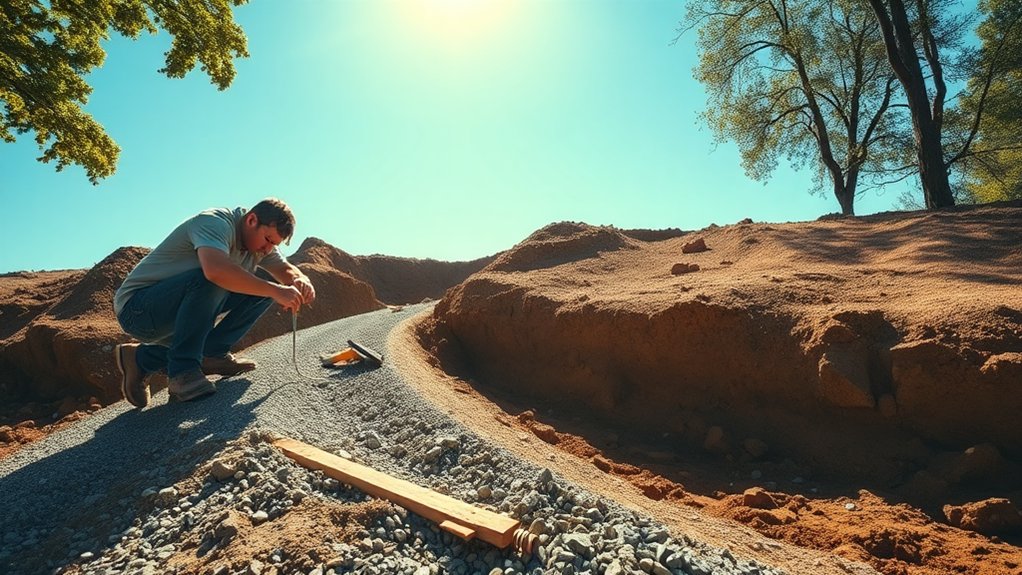
When preparing the base layer for your sloped driveway, it’s crucial to choose the right base material for stability and support. Proper compaction of this material is equally vital, as it helps prevent future settling and keeps the driveway intact. By prioritising these two elements, you can establish a robust foundation that can handle the challenges of a slope. For instance, using gravel or crushed stone can provide excellent drainage and support, making them ideal choices for sloped driveways. Additionally, ensuring the sub base is installed with a slight slope is essential for effective water runoff. Implementing effective drainage systems like French drains will further enhance the longevity of your driveway by preventing erosion.
Base Material Selection
Selecting the right base material is crucial for creating a stable and durable driveway on a slope. Consider materials that enhance drainage and resist erosion. Here’s a straightforward comparison of suitable options:
| Base Material | Cost per Tonne | Key Characteristics |
|---|---|---|
| CA6 Road Mix | £32 | Stability, excellent drainage |
| Crushed Stone | Varies | Superior drainage, ideal for freeze-thaw |
| Gravel (Irregular Shapes) | Varies | Efficient water passage, reduces erosion |
| Dense-Graded Gravel | Varies | Recommended for permeable systems |
| Mixed Aggregate Base | Varies | Balances compaction and drainage benefits |
When choosing your material, consider its environmental impact and long-term sustainability. Opt for materials that reduce future repair costs and effectively manage moisture. A well-constructed base layer is essential for the longevity of a sloped driveway. Proper drainage management is also critical to avoid water pooling that can lead to structural issues.
Compaction Process Importance
To ensure a stable and durable driveway on a sloped surface, it’s crucial to understand the compaction process. Proper compaction increases the density of the base layer, which helps prevent erosion and settlement over time.
Techniques like layering promote even density distribution without compromising the soil’s stability. Monitoring moisture levels is essential; achieving the right moisture content is key for effective compaction.
For smaller areas, use a vibratory plate compactor, whereas larger projects may require a vibratory roller. Be cautious of over-compaction, as this can weaken soil strength and heighten erosion risks.
Paver Installation Techniques
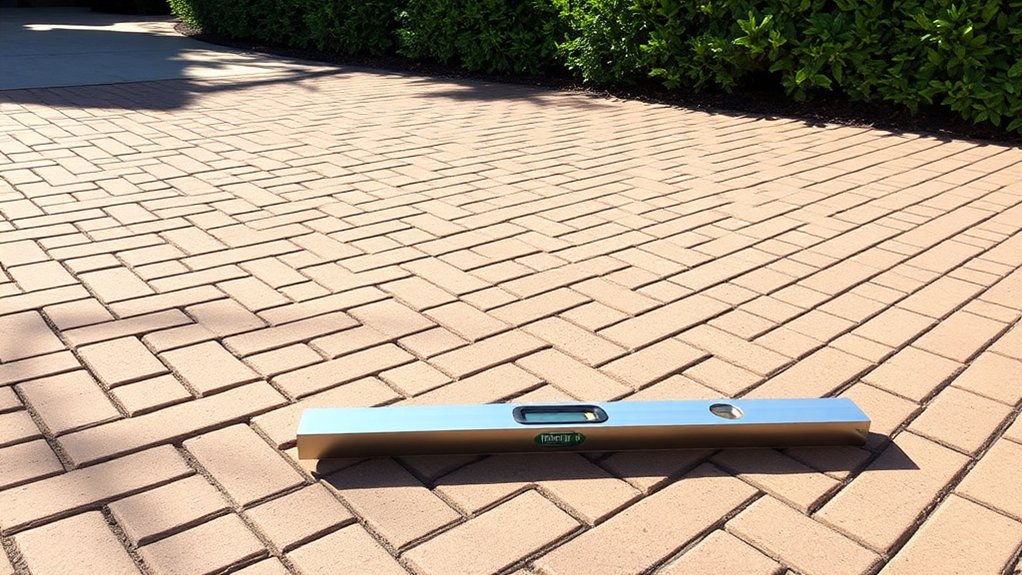
Installing pavers on a sloped surface requires careful planning to ensure they last and function well. Start by grading the slope to around 2% to facilitate drainage. Make sure to excavate and compact the sub-base properly.
To prevent erosion, consider using slope stabilisation methods like geocell systems.
When laying the pavers, begin at the bottom and work your way up, ensuring they’re aligned correctly for a uniform look. Interlock the pavers tightly and tap them down with a rubber mallet for a secure fit.
Regularly check that they’re aligned and maintain the correct slope to prevent any unevenness.
Lastly, install edge restraints to keep the pavers in place and stop them from shifting. Following these steps will help you achieve a stable and effective driveway on a sloped surface.
Effective Drainage Solutions
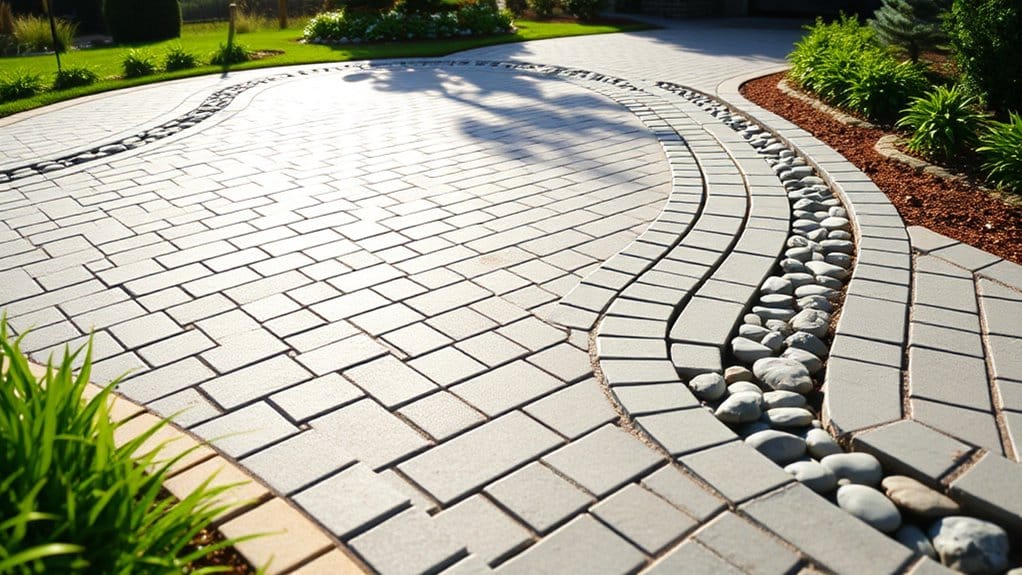
When it comes to effective drainage solutions for a sloped driveway in the UK, managing water is key to preventing pooling and erosion.
A good drainage system not only protects the driveway but also helps stabilise the slope. Here are some straightforward strategies:
- Install channel and trench drains to redirect surface water.
- Use catch basins and soakaways for managing runoff on-site.
- Consider permeable paving to allow water to soak through.
- Create diversion channels or swales to guide water away.
- Adjust the driveway’s pitch through regrading to improve drainage.
By implementing these solutions, you can effectively manage water and protect your driveway and property from damage.
A well-drained driveway ensures safety and functionality, especially on sloped surfaces.
Erosion Control Strategies

Effective drainage solutions are essential for erosion control on sloped driveways. To reduce erosion, use vegetative barriers such as grasses, shrubs, and trees; these help anchor the soil and lessen runoff.
Ground stabilisation mats or pavers can also improve slope stability by spreading out water flow and preventing soil displacement.
Incorporating hydrological management methods, like permeable pavers and vegetated swales, can effectively manage stormwater runoff and minimise erosive forces.
On steep slopes, consider using riprap to create a robust barrier against erosion.
Regular inspections and maintenance of these measures will ensure they remain effective, providing a stable and durable driveway that can withstand the challenges of sloping surfaces.
Maintenance and Repair Practices
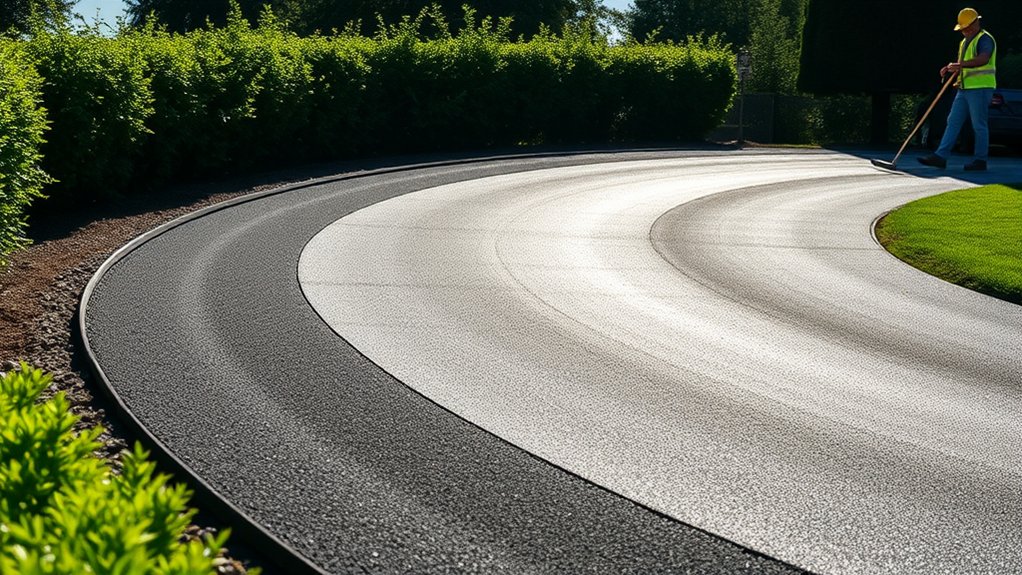
To keep your sloped driveway in good condition, set up regular inspections to check for surface problems like gravel displacement and potholes.
Use effective cleaning methods to clear away debris that can trap moisture and lead to quicker deterioration.
When you notice any damage, act promptly to carry out repairs, ensuring the driveway remains safe and structurally sound for everyone.
Regular Inspection Protocols
Regular inspections are vital for ensuring the safety and integrity of a driveway on a slope. They help you spot potential issues before they turn into expensive repairs.
To ensure thorough inspections, set a regular schedule and keep your checklist updated:
- Examine the driveway surface for cracks and potholes.
- Look for weeds growing in cracks and along the edges.
- Check that drainage systems are clear and functioning properly.
- Ensure the slope complies with local regulations.
- Record your findings and any repairs undertaken.
Effective Cleaning Techniques
Cleaning a sloped driveway effectively involves a clear plan to keep it looking good and structurally sound. Regular cleaning is essential to prevent dirt build-up and stains. Begin by clearing away loose debris, then pressure wash from the highest point to the lowest to avoid contaminating cleaned areas. For an even finish, use a surface cleaner attachment and opt for biodegradable cleaners to help prevent stains.
| Step | Technique | Frequency |
|---|---|---|
| Pre-Cleaning | Clear debris | As needed |
| Pressure Washing | Use a low PSI surface cleaner | Every 6 months |
| Stain Treatment | Apply degreaser and scrub | As stains occur |
Swift Repair Actions
Maintaining a sloped driveway involves more than just cleaning; prompt repair actions are crucial to ensure its structural integrity and functionality.
Taking immediate action helps keep your driveway safe and durable.
- Use interlocking pavers like TRUEGRID to stabilise gravel and prevent erosion.
- Employ a driveway scraper to quickly level low spots and maintain the slope.
- Regularly inspect and redistribute gravel to avoid exposing the base to erosion.
- Create drainage ditches to direct water runoff and reduce washouts.
- Address any washouts or damage promptly after heavy rain or freeze-thaw cycles.
Sustainable Materials for Driveway Construction
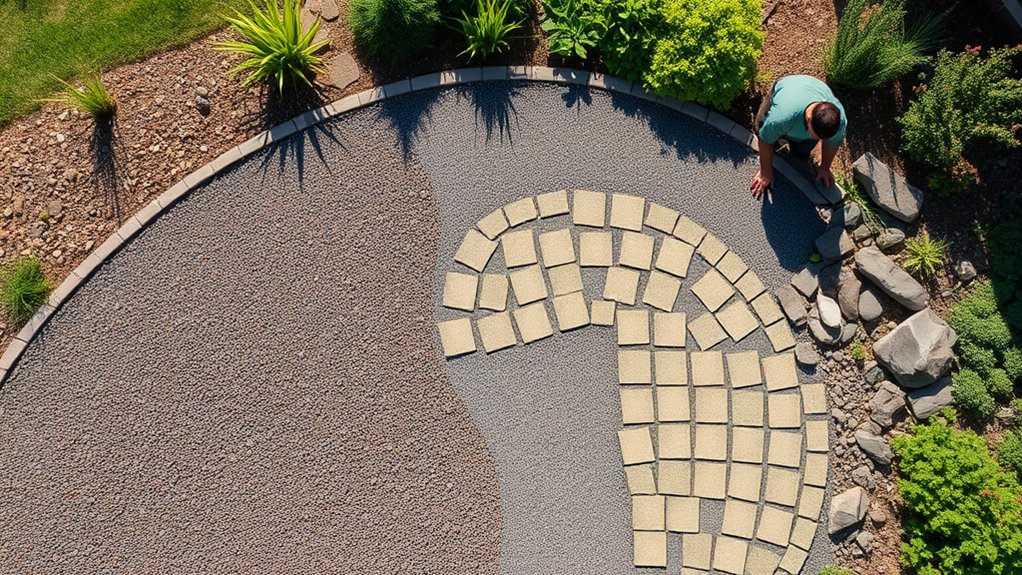
When choosing sustainable materials for driveway construction on sloped surfaces, it’s important to find options that are environmentally friendly yet effective.
Permeable plastic pavers, made from 100% recycled materials, allow for 98% water permeability, helping to reduce erosion. With a lifespan of up to 60 years and requiring minimal maintenance, they’re a durable choice.
Recycled concrete is another good option, as it repurposes waste while providing the strength needed for steep slopes.
Gravel combined with stabilisation grids also improves erosion control and drainage, utilising natural or recycled stone.
Although rubber tiles have limitations in certain climates, they offer slip resistance and incorporate recycled content.
Each of these materials contributes to a sustainable driveway that meets both practical and environmental standards.
Frequently Asked Questions
How Do I Determine the Ideal Slope Angle for My Driveway?
To find the ideal slope angle for your driveway, start by assessing the gradient. Aim for a slope between 2% and 5%. This range helps drain water effectively, preventing puddles and ensuring vehicles can access your drive safely. For example, a slope of 2% means a drop of 2 centimetres for every 100 centimetres of length, which is manageable and practical.
What Tools Are Necessary for Driveway Installation on a Slope?
For installing a driveway on a slope, you’ll need a few essential tools: laser levels for accurate measurements, shovels for earth moving, and diamond-bladed saws for cutting materials. These tools are crucial for managing driveway materials effectively and ensuring stability on sloped surfaces.
Can I Use Concrete or Asphalt on a Sloped Driveway?
You can use either concrete or asphalt for sloped driveways, but it’s important to consider how each material handles drainage on slopes. Concrete is known for its durability, while asphalt offers better traction and is easier to resurface. Choose based on your specific needs and local conditions. For instance, if you live in an area with heavy rainfall, the drainage capabilities of each material should be a key factor in your decision.
What Are the Costs Associated With Sloped Driveway Installation?
Think sloped driveways are inexpensive? Think again! Installation costs can quickly add up due to material expenses, excavation, and permits. You’ll need to budget for everything from gravel to hiring professionals—unless you fancy a DIY disaster.
How Do Weather Conditions Affect Driveway Construction on a Slope?
Weather significantly affects driveway construction on slopes. Heavy rainfall can exceed the capacity of drainage systems, resulting in erosion. For instance, if a driveway is built without proper drainage, you might find it washed away after a heavy downpour. Moreover, temperature changes can weaken materials, making it crucial to choose the right ones for durability. Overall, effective drainage and careful material selection are vital for ensuring a long-lasting driveway on a slope.
Conclusion
Laying a driveway on a sloped surface requires careful planning. Choose the right materials and ensure proper drainage to avoid issues later. Don’t forget about erosion control and regular maintenance; these steps are crucial for longevity. A well-thought-out approach can prevent future problems. With attention to detail, you’ll create a durable and functional driveway.
How can a tarmac driveway enhance your home's appeal? Discover the key aspects of cost, installation, and maintenance in our Read more
Not sure if you can lay tarmac over your existing driveway? Discover the crucial steps and benefits you need to Read more
Investing in a driveway? Discover whether tarmac or resin is the more affordable option and what long-term benefits await your Read more

